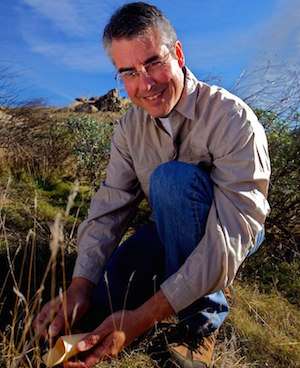“The objective now is to understand which kinds of species died during this extreme drought to determine which strategy is winning out," says UC Riverside's Louis Santiago. Credit: L. Duka
As is well known now, California is in its fourth year of drought. As a result, mass mortality of trees and shrubs is happening more quickly than researchers can quantify. Rapid changes in vegetation cover are already leading to loss of biodiversity, opportunities for invasive species, and novel ecosystems with entirely new plant communities.
Louis Santiago, an associate professor of botany and plant sciences at the University of California, Riverside, has now received a grant of $180,000 for two years from the National Science Foundation to study how trees and shrubs respond to extreme drought.
"The current California drought represents the driest three-year record in the state's history," he said. "We know that many trees and shrubs have died during this extended drought. Unfortunately, we still cannot predict which plant species will suffer most mortality and which species are likely to survive during the next extreme drought. It is now urgent that we link the identity of survivors with physiological mechanisms, such as deep roots or specialized leaf and wood types, so that in future droughts, we can predict which plants will live and which ones will die."
The xylem is a plant's transport tissue that moves water from the roots to the leaves, much like the way arteries and veins move blood around in humans. However, drought can cause "xylem cavitation," a breakdown in the water-conducting system that cuts off the water supply to leaves and leads to plant death. According to Santiago, drought survival mechanisms among California shrubs vary from species with deep roots to other species with a xylem that is very resistant to damage.
"The objective now is to understand which kinds of species died during this extreme drought to determine which strategy is winning out," he said.
Santiago believes that deep roots are the key. If drought becomes more severe in the future, species with shallow roots are in danger of becoming locally extinct even if they have a xylem that is resistant to damage. This is because high temperatures associated with global warming intensify drying of the soil.
The study site is in Morongo Valley, Calif., where chaparral shrubs meet the Mojave Desert. Most plant species exist near the edge of their range here, heightening the threat of local extinction.
"We will conduct the study on a series of long-term permanent plots here," Santiago said. "We will go through and characterize which species suffered heavy mortality and which species were the survivors, then relate this to the physiology of each species. We already have a lot of data on how these species differ in their physiology and can't wait to study how these different strategies performed during this drought of the past four years."
Santiago will be joined in the study by graduate and undergraduate students and will use new techniques using stable isotopes to measure rooting depth of intact plants, leading to new discoveries.
"The upcoming El Niño event, which is expected to bring abundant rain to California this year, offers an unparalleled opportunity to identify survivors because many species lose their leaves during drought and it can be hard to distinguish live from dead plants," Santiago said. "If the rains arrive as predicted, you can be sure that every surviving tree and shrub will be leafing out to take advantage of this resource. It has been a long drought."
Provided by University of California - Riverside






















